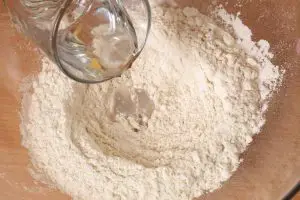Some bread recipes call for kibbled (cracked) grains and seeds, which give the bread a distinct flavor and coarse grain texture. These grains and seeds also provide additional health advantages by providing more fiber, vitamins, and minerals that can only be found in whole grains. When you include these sorts of components in your sourdough, it necessitates the addition of a soaker stage to the bread dough’s growth.
The ingredients are soaked in water for a minimum of 24 hours at room temperature before being added to the bread dough at this stage. Kibbled wheat, kibble rye, oats, and linseed or flax seeds are common soaking ingredients. These seeds would be too hard to consume without soaking, and the resultant bread would be largely indigestible.
Soakers help boost the dough’s natural sweetness and maltose content. The bread will have a rich flavor profile with sweet and sour undertones and a wet crumb that will improve the bread’s shelf life.
What is a Soaker?
When an ingredient is soaked in water for an extended time, it is referred to as a soaker. A total of 2 to 18 hours are required to complete the process. Because of this, the flavor of the components is enhanced, dry ingredients are prevented from absorbing water from the dough, and large grains may be utilized to make bread instead of little grains.
The seeds and dry components absorb the moisture in the dough. They are frequently sluggish to achieve this, resulting in a great dough becoming a dried mess 30 minutes after it was created. The seeds will benefit greatly from soaking in water overnight to help them become more hydrated. By soaking the seeds, it is possible to get higher precision in the dough’s hydration.
Salting the soaker increases the scent of the seeds, allowing you to use less of the seeds while still getting a richer flavor and more perfume. The amount of salt used in the dough mix should be reduced.
How to Make a Soaker?
The first step in making a soaker is adding the dry ingredients. If you are using an electronic kitchen scale, begin by adding the dry ingredients one at a time, making sure to zero the scale after each item is added. Alternatively, you may use the cumulative weights of the elements specified in the recipe to constantly add to the mixture. Using cumulative weights on balance type scales is considerably more convenient than individual weights.
It is simpler to remove extra flour from the scale dish if you gently flatten the dry ingredients that have already been added. When adding several dry ingredients, gently flatten the previously added items in the scale dish and add the following ingredient as a fresh mound.
Place the weighted ingredients in a container with a tight-fitting cover; ensure that the plastic containers are free of BPA.
Prepare the necessary water component by weighing it out. Preferably filtered water should be used for making a soaker. Fill the jar with the soaker components with water and stir well. Many people recommend using a whisk to mix everything. Make use of a spoon to ensure that all ingredients are equally combined with the water before serving.
Leave the soaker at a spot in your home that maintains a steady temperature and is free of drafts – preferably at 68 degrees Fahrenheit. Allow the number of hours specified by the recipe to elapse before using.
What Does a Soaker Do for Bread?
Soaking seeds and grains, but particularly grains, before baking with them is highly recommended for several different reasons. The first reason is it softens them, making them more pleasant in the mouth and simpler to chew entirely, preventing them from breaking your teeth or removing your fillings, as well as making them easier to digest.
Second, it fills them to capacity with moisture to not suck moisture from the dough while it is rising. This is especially crucial when baking sourdough bread since it stays about for a lengthy time, giving the seeds and grains plenty of opportunities to replenish themselves at the price of your bread’s flavor.
It also helps them be more digestible by breaking them down before they reach your digestive tract. Plus, after soaking and rinsing, the amounts of phytates contained in seeds and grains are lowered, which is beneficial to your health in the long run.
Indulging raisins and other types of dry fruit in water is nice but not necessary. People do this because it makes the fruit plump, juicy, and delicious in your bread, and it prevents the fruit from becoming stuck in your teeth, which leads to faster tooth decay and the need for emergency tooth picking in public places.
It is possible to utilize some of the liquid you are soaking fruits in your bread recipe, whether you are soaking fruits in water or juice. If you’re cooking a loaf of bread for adults, try rum, brandy, or wine. If you are baking bread for a large group of people, use water, tea, or juice.






